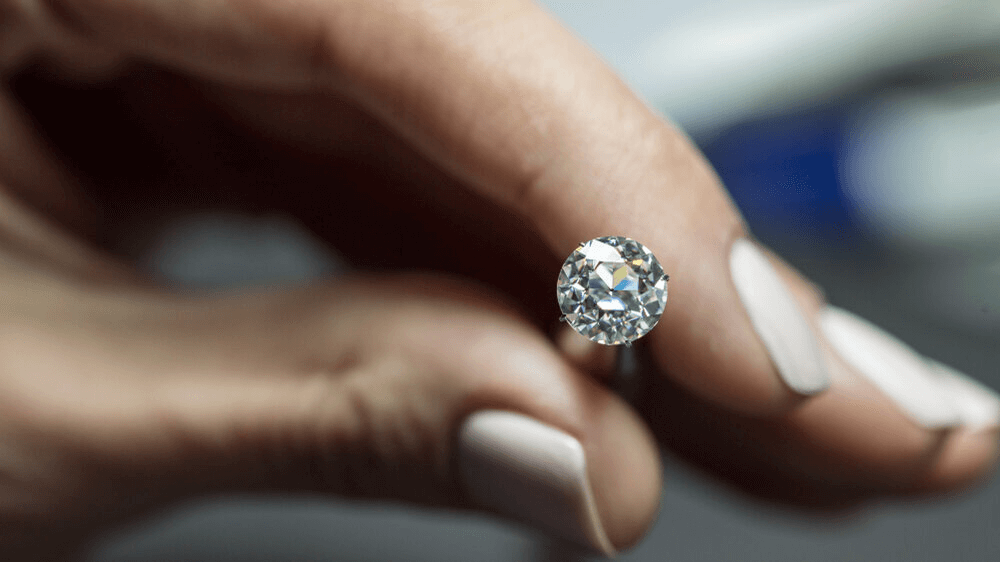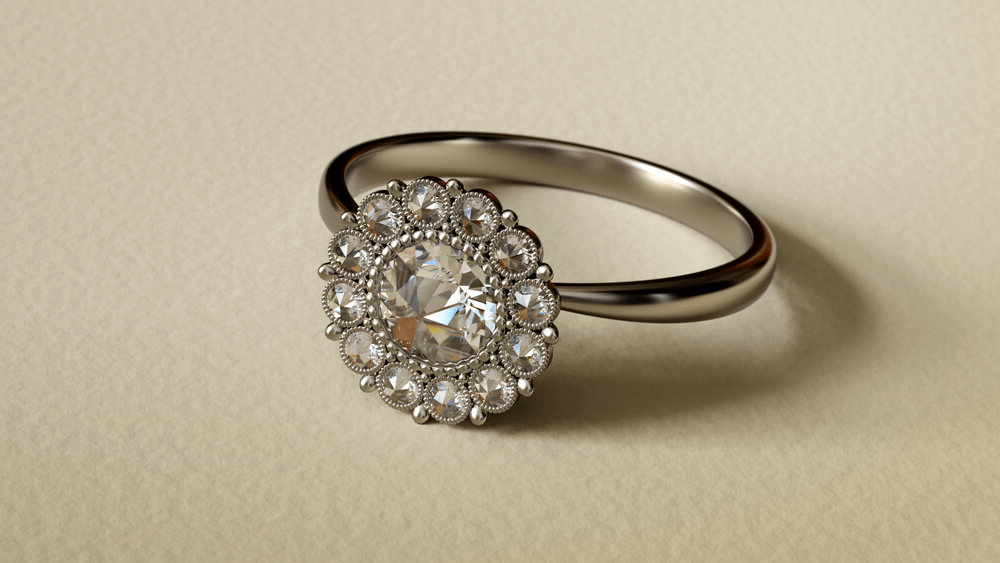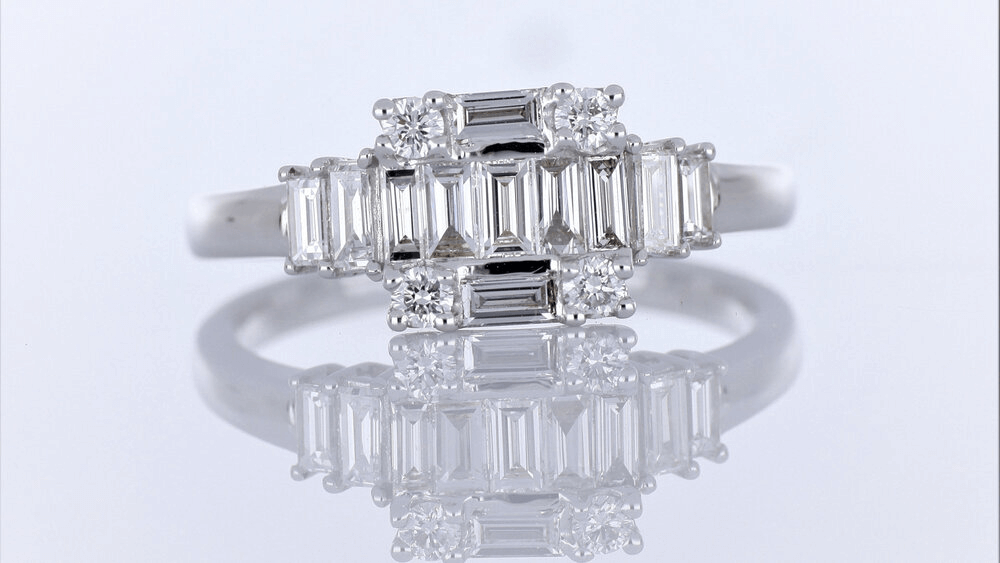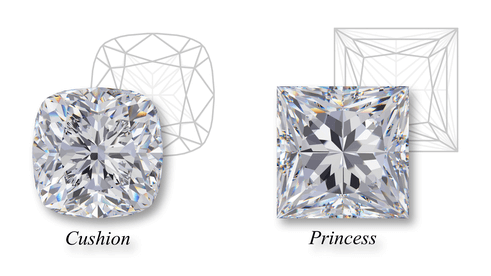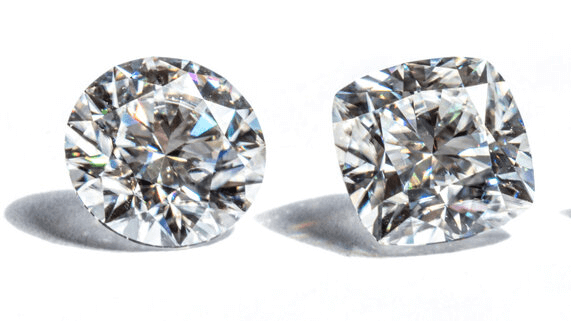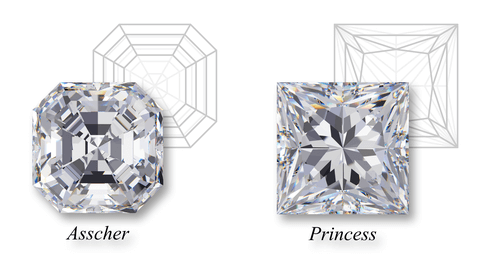Radiant vs. Emerald: The Ultimate Showdown of Diamond Cuts

By Gary A.

Edited by Olivia H.
Published Aug 8, 2022
Edited on Dec 18, 2024
When comparing the brilliance of a Radiant cut with the elegance of an Emerald cut, understanding their unique features can make all the difference in choosing the perfect diamond.

Navigate This Guide:
- Radiant Cut vs Emerald Cut: 6 Quick Tips for Diamond Engagement Ring Selection
- Introduction
- Brilliance and Elegance: Light Performance Compared
- Versatility in Engagement Ring Design
- Size and Appearance: Face-Up Impressions
- Decoding Color in Diamond Selection
- Clarity in Emerald and Radiant Cuts
- Cost Comparison: Investing in the Right Cut
- Our Expert Take
- 10 FAQs
Before we dive deeper into the specifics, here are some practical tips to help guide your decision-making process:
Radiant Cut vs Emerald Cut: 6 Quick Tips for Diamond Engagement Ring Selection
Tip 1: Understanding Light Performance and Brilliance
Radiant Cut: Known for its brilliance and fire, the Radiant cut reflects light intensely, creating a dazzling sparkle. When examining a Radiant cut diamond, observe how light interacts with the facets. Look for uniform brilliance and avoid stones with ‘dead spots’ where light doesn’t reflect well.
Emerald Cut: Characterized by a more subdued, elegant shine. Focus on the clarity and transparency of the Emerald cut. Its large, open table (top surface) makes inclusions more visible, so prioritize a higher clarity grade.
Tip 2: Evaluating Size and Shape for Aesthetic Appeal
Radiant Cut: Often appears larger than an Emerald cut of the same carat due to its cut style. Pay attention to the length-to-width ratio; a more elongated Radiant cut can make the finger look slimmer.
Emerald Cut: Offers a classic, elongated appearance that emphasizes the diamond’s size. Check the proportions and ensure the cut is symmetrical. A well-proportioned Emerald cut enhances elegance and finger elongation.
Tip 3: Assessing Color Grades and Tones
Radiant Cut: This cut can hide color better than the Emerald cut. If you’re on a budget, you can opt for a slightly lower color grade without compromising the diamond’s appearance.
Emerald Cut: More likely to show color due to its large, open facets. Consider a higher color grade, especially if the diamond is larger, as any color tints are more noticeable in Emerald cuts.
Tip 4: Considering Versatility in Ring Design
Radiant Cut: Modern and versatile, suitable for various ring styles from classic solitaires to intricate halos. When choosing a Radiant cut, consider contemporary designs that complement its brilliance.
Emerald Cut: Ideal for vintage-inspired designs. Its clean lines and understated elegance pair well with simpler settings. Ensure the setting you choose doesn’t overpower the Emerald cut’s unique beauty.
Tip 5: Analyzing Price and Value
Both cuts are generally more affordable than round brilliants. However, due to the Radiant cut’s complexity and brilliance, it might be slightly more expensive than the Emerald cut. Balance your budget with the desired visual impact. Remember, a larger Emerald cut may cost less than a smaller Radiant cut with the same level of brilliance.
Tip 6: Inspecting the Diamond in Various Lighting Conditions
Diamonds can look different under store lighting versus natural light. Inspect your chosen diamond in multiple lighting conditions to get a true sense of its color, clarity, and sparkle. This is especially important for Radiant cuts, where the brilliance can vary significantly with lighting.
Now that you’ve got these practical tips, use Jeweler AI below to find the perfect engagement ring that suits your style and budget:
Introduction
When it comes to the topic of diamond shape, we talk a lot about the ‘silhouette’ – the bare-bones outline of the cut, rather than the specific features of the diamond itself. While those features are make-or-break to the beauty of the finished ring, it’s always worth taking time to think about the basic details, too.
If you’re thinking about silhouette alone, then the Radiant cut and the Emerald couldn’t be more similar. Both are cut to rectangular proportions, with neatly beveled corners that create a very attractive, elegant shape on the finger. As a silhouette, this is incredibly flattering, particularly when the diamond is oriented North-South (as it usually is) since the longer length of the two vertical sides helps to create an elongating effect on the finger.
It’s only once you get past the silhouette and start to take in the two diamonds’ characteristic features that you start to notice some very big differences between them – as well as a couple similarities that can make the choice harder than you’d think.
If you’re on the fence between the two cuts, then you wouldn’t be the first – and you definitely won’t be the last. Read our full, point by point comparison of the Radiant cut and the Emerald cut below.

Emerald Cut: A Timeless Classic
The Emerald cut is what’s known as a ‘step cut’ – the opposite, in a way, to the brilliant or modified brilliant cuts, like the Round (the original Brilliant) and the Oval, Marquise and Pear.
Step cuts feature facets that are longer and more ‘open’ than they are for a brilliant facet pattern. The result is something that is lacking the same bright, scintillating light performance of fire and brilliance; instead, it offers an elegant and more understated shine. Emerald cuts can appear to glow under the right light source, a little like the moon on a clear night.
The Emerald cut is pretty old – about 500 years, give or take – and has seen sustained popularity in the jewelry world. It’s not as popular as some of the modified brilliants (or, of course, the Round itself) but it is the most popular step cut on the market today.
The Emerald cut has 57 facets, all arranged parallel to one another. It’s unlike any other shape out there, and much more ‘sleek and streamlined’ than other shapes.
Radiant Cut: Modern Brilliance Unleashed
The Radiant cut is a very interesting one. As one of the modified brilliants, it features those triangular ‘brilliant’ facets as you’d expect – but there’s something that sets it apart from the likes of the Oval, the Cushion, and the Marquise.
The Radiant was created to meld together features of the modified brilliants, and features of the step cuts. Essentially, it’s exactly what you’d get if you somehow found a way to combine the Emerald with For this reason, it’s occasionally referred to by jewelers as a ‘brilliantized’ step cut.
The effect is truly unique – and, while the Radiant doesn’t make its way into as many engagement rings as some of the more popular shapes, it’s incontrovertibly distinctive…a true modern classic of the world of fine jewelry.
The Radiant cut has as many as 70 facets – a lot more than the Emerald cut – and they’re all arranged in a much more complex pattern. This creates a sort of ‘crushed ice’ effect not all that different from the Cushion cut, but within a more streamlined shape.
Brilliance and Elegance: Light Performance Compared
A diamond’s light performance usually ranks as one of the most significant concerns a shopper has. Alongside the sheer size of the diamond, ensuring that we bring home a stone that is going to live up to every one of our partner’s expectations. After all, diamonds are famed for their brilliance and fire.
‘Getting maximum sparkle for your buck’ is a philosophy that drives a lot of shoppers toward the Round Brilliant. When cut to a high standard, it produces a superior light performance that makes it the clear choice for anyone who wants to create fireworks on their partner’s finger. This boils down to the incredible brilliant facet pattern.
Speaking of brilliant facet patterns, this is one of the key differences between the Radiant and the Emerald cut. With those triangular facets placed base-to-base, the Radiant creates a stunning light performance of brilliance and fire. While it’s short of the Round Brilliant, it’s not disappointing; light flits across the surface and catches the eye in a gorgeous display that lives up to expectations, even if it doesn’t do it with quite the same vibrancy as the O.G. of the engagement ring world.
Emerald Cut’s Understated Elegance
By contrast, the Emerald is very subdued. If you’re looking for a sparkly diamond then, however beautiful and elegant the Emerald looks, it really isn’t the right pick for you. If, on the other hand, you’re willing to sacrifice that scintillating light performance for the bright sheen, the bigger flashes, and the classic glow of the Emerald, it’s a great pick.
Radiant Cut’s Dazzling Brilliance
In terms of sparkle, then, we’d have to say that the Radiant is the clear winner. But keep in mind that sparkle doesn’t have the be ‘everything’, and that the vibrancy of a cut’s light performance isn’t the only point of comparison you need to be making at this stage.
Versatility in Engagement Ring Design
The Emerald is great with pavé or channel set diamonds along the shank – or, if you want to channel Beyoncé’s own style, a split shank ring setting.
But the Emerald’s powers don’t just stop there. It also makes for an incredible pairing with other diamond shapes – particularly the Round or modified brilliants. The contrast between the Emerald’s simplicity and the dazzling scintillation of the other diamond(s) is really something, and it works for halo rings, three stone engagement rings (picture an Emerald cut flanked by two Radiant diamonds, or two Cushion cut diamonds) or the toi et moi ring style.
Vintage Vibes: Emerald Cut in Engagement Rings
One thing we love about the Emerald cut is, if you’re looking for a versatile shape that can scream ‘on theme’ or simply look beautiful, classic, and elegant, it’s right up there at the top of the list. For vintage engagement rings, the Emerald is a strong choice; its shape and facet pattern are strongly evocative of the Art Deco obsession of the 1920s and, for that reason, even the simplest Emerald solitaire engagement ring on a plain gold shank will be capable of evoking that same sense of classic glamour and beauty. For something more modernized, however, pair it with a platinum shank.
Contemporary Elegance: Radiant Cut in Modern Settings
The Radiant is also versatile, but not in quite the same way as the Emerald cut. It’s a much more modern cut style than the Emerald and, like the Princess, it really does have a more contemporary look to it than some of the more traditional cuts. This doesn’t need to be a downside if you’re not interested in channeling vintage styles in your ring design, however.
The Radiant cut’s incredible sparkle means that it looks stunning in a simple solitaire, or surrounded by a halo of glimmering melee diamonds. For contrast, you could pair your Radiant diamond with a Baguette cut diamond on either side.
Size and Appearance: Face-Up Impressions
A diamond’s face-up appearance is a key concern for shoppers. While the overall size of a diamond is important, the crown and table are what we will see once the diamond has been mounted in its setting.
This preoccupation with size means that there are a lot of spready diamonds on the market – diamonds that have been cut with as large a face-up appearance as possible. These diamonds are a terrible investment since, if you want to get a good light performance, a diamond has to fit within the ideal parameters for proportion and length to width radio.
This means that, generally, shoppers gravitate towards shapes that naturally require the diamond cutter to distribute more of the diamond’s carat weight across the top, rather than in the pavilion. The Oval cut, for instance, is one of the larger presenting diamonds, whereas the Cushion cut has a much deeper, plumper overall shape. There is a benefit to this depth (the Cushion creates much more fire than most other shapes) but if size is the aim of your game, focus on the cuts with larger face-up appearances.
We mentioned at the beginning of the article that the Emerald and Radiant cut share very similar silhouettes. While everything within those silhouettes is different, the basic shape is the same. As you’d expect, that means that the Emerald cut and the Radiant cut are pretty much on a par with one another in times of size. This doesn’t just apply to their upper portion, but their lower portion too – meaning, all-round, they’re pretty much tied in terms of size.
Two one carat diamonds, one Emerald and one Radiant, will both measure in around about 7mm in length. At higher carat weights, the Emerald will be just a little larger than the Radiant, but the difference will be minor.
Remember that these measurements are dependent upon the Cut quality of the diamond. Badly proportioned diamonds will present very differently, and lack that beautiful light performance you’re looking for.
Decoding Color in Diamond Selection
One thing anyone interested in an Emerald cut must confront head-on is that its open table and facets make it more susceptible to showing off its color. Unless you’re going for a fancy color Emerald cut diamond, this is going right to the top of your list of concerns when you actually start looking for a diamond to invest in.
That’s not to say that you’ll have to pay a premium for a totally colorless diamond. Emerald cuts are tricky, but not impossible, and you’ll definitely have plenty of luck looking in the Near Colorless range (on the GIA’s scale). You’ll want to focus to the higher grades – say, G and H – particularly if your diamond is on the larger side.
An Emerald with a very slightly amount of color in it can be improved with a halo. Provided the melee diamonds used in the halo are a lower color grade than the center diamond, they can ‘elevate’ its color. Obviously, this isn’t an exact science, and the wrong choice of diamonds could lead to a ring that just looks off-white
On the other hand, the Radiant can take advantage of those smaller, clustered facets and vivid light performance. As a result, any slight traces of color are pretty well masked – although, as you can imagine, there is a line you don’t want to cross. Once again, you’ll want to stick to the Near Colorless range but, thanks to the Radiant diamond’s facet structure, you’ll be able to save some money by dipping down to the lower grades.
In either case, don’t waste your money on the Colorless grades (D, E, and F), and don’t waste your chances at a beautiful diamond on the Faint grades (K, L, and M).
There’s not a massive price difference between each color grade, but it can amount to a couple hundred dollars, so it’s always worth figuring out exactly what you can afford to pay (and sacrifice).
Metal Setting Color
This is definitely something to consider if you’re on the fence between the two. While platinum and white gold aren’t going to mess with your diamond’s color, the warm tones in yellow and rose gold are often guilty of reflecting through white diamonds, and, put simply, undermining a diamond’s lack of color.
The Emerald is one of the shapes most impacted by this phenomenon. Paired with a yellow gold shank and setting, the Emerald cut can clearly take on a yellow ‘shadow’, visible through the table and crown.
For a lot of people, this isn’t a negative. The Emerald’s step cut facets create a ‘hall of mirrors’ effect visible through the table, and the reflection of the yellow or rose gold running through it can be very beautiful. It also means you don’t have to go too high on the color scale, since a very highly graded diamond will be ‘wasted’ on the ring setting. Besides, the eye can generally tell the difference between a yellow diamond, and a diamond that has taken on some of the warmth of its setting.
To minimize this, you can ask your jeweler to combine a yellow or rose gold shank (depending on your preference) with a white gold or platinum prong setting, so that the diamond isn’t actually coming into direct contact with the warmer metal color.
The Radiant cut’s facet structure means that, compared with the Emerald or Asscher cuts, it’s a lot less likely to allow gold to reflect through its center.
Clarity in Emerald and Radiant Cuts
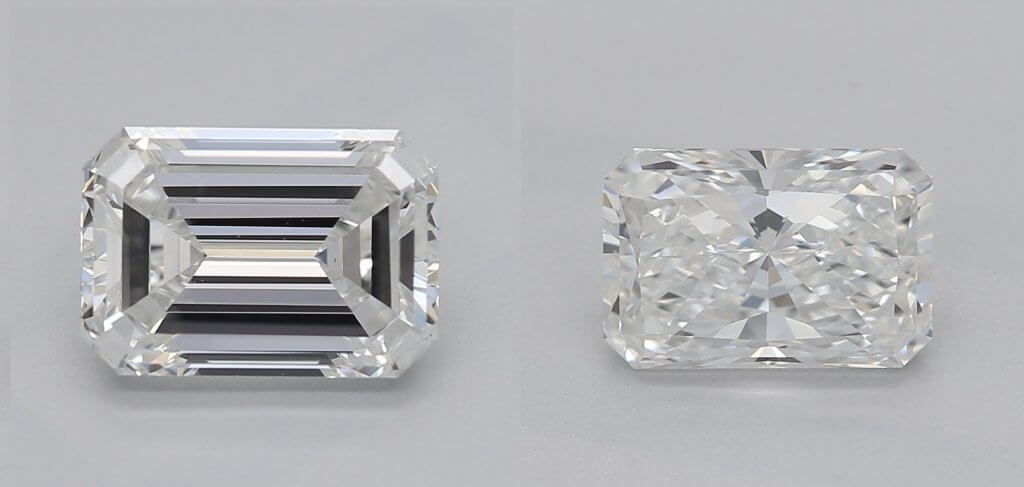
The Emerald is, again, the trickier cut when it comes to clarity. That open table we mentioned in the previous section, and those wider, longer facets, make it a lot easier for you to see into the very heart of the diamond. You don’t have the flashes of fire and brilliance getting in the way, and any slight inclusions are going to be all the more noticeable than they would be in a modified brilliant diamond.
In fact, the Emerald cut was first established to show off the innate beauty of diamonds. Everything about them is intentionally pared back to reveal a side to the gemstone that we don’t often get to see. The one way to ruin it is, unfortunately, to pick out a stone with visible inclusions.
Even if you think you can see past them – even if they’re incredibly minor – it’s all too often true that buyer’s remorse begins to set in when that little mark or cloud becomes the most obvious feature of all. This is the case for any diamond shape, but it’s definitely magnified in Emerald cuts.
As with color, that doesn’t mean you have to pay a high premium for one of the very top Clarity grades. Avoid the VVS grades, and focus on VS1 and VS2. If your diamond is on the smaller side, then consider looking at a couple choices in the SI1 range to save yourself some money.
By contrast, the Radiant cut is a lot better at masking minor inclusions. If Clarity is something you’re particularly concerned about, we’d probably recommend you focus your search on the Radiant rather than the Emerald.
Whatever shape you’re going for, take a look at our guide to eye cleanliness in diamonds.
Cost Comparison: Investing in the Right Cut
Both the Emerald and the Radiant cuts are among the more affordable options for diamond hunters. While both cuts have plenty of admirers, they’re definitely not counted amount the most popular shapes – the Round, Oval and Princess.
The Emerald is one of the very cheapest diamonds, meaning shoppers can get a lot more carat weight for their investment than they would have got for a Round diamond, say. It’s a simpler cut, and its lack of sparkle makes it a more ‘controversial’ choice for engagement rings, so they tend to be available at a much more reasonable price point.
Remember, however, that you may need to go for a higher clarity grade than you would have needed for a different diamond shape. The difference will be relatively minor compared with the overall cost of the diamond, but it’s worth remembering it’s slightly harder to be economical with the Four Cs when it comes to the Emerald cut.
The Radiant cut is still a good alternative to the more popular modified brilliants. If you love the look of the Princess cut, for example, but want to be able to get a little more carat weight for your money, then a Radiant is a clever alternative. Radiant diamonds cut to square proportions are available if you want to get a closer mimic, but we love the flattering, lengthening effect the rectangularly-proportioned Radiant cut gives to the finger.
Our Expert Take
If you were looking for a diamond shape that flatters the finger, offers plenty of versatility, looks stunning when the light hits and shows off exactly how beautiful a diamond can be, then you came to the right place. The only trouble? Choosing between these two options that are, in some ways, quite similar – but, in other ways, total opposites.
It’s not an easy choice, but it is definitely possible, even if it takes you some time. Think about your partner’s sense of style. Are they classic and chic, or a little more contemporary and ‘out there’? Do they lean toward minimalism and simplicity, or do they prefer to put themselves and their personalities out there?
Obviously, it’s not as simple as answering a couple questions, but it can definitely help to get the answers to these kinds of questions straight in your head before you head to the jewelry store. Your jeweler will have plenty of questions of their own, and the process will be a lot easier if you’ve put in some practice beforehand. Nobody likes to be put on the spot – especially when it’s for something as important and life-changing as this.
Ultimately, if you can’t decide, the best thing you can do is speak with an experienced local jeweler about your options. They won’t be able to give you a clear answer, but they will be able to point you in the right direction, inspire you, and work with you to create a clear and unique set of criteria for your ring’s design. You can find a respected local jeweler through our Store Locator. Every jeweler we list has been personally approved by the team at WillYou.com, and meets our own high standards.
10 FAQs
- Q: Which Diamond Cut is More Brilliant, Radiant or Emerald?
A: The Radiant cut is more brilliant. It has numerous facets designed to maximize light reflection, creating a more dazzling sparkle compared to the understated elegance of the Emerald cut. - Q: How Does the Emerald Cut Differ in Appearance from the Radiant Cut?
A: The Emerald cut has long, step-cut facets that produce broad flashes of light and a “hall of mirrors” effect, offering a classic, elegant look. The Radiant cut features brilliant-cut facets, resulting in a more sparkling and lively appearance. - Q: Are Emerald Cut Diamonds More Expensive Than Radiant Cuts?
A: Generally, Emerald cut diamonds are less expensive than Radiant cuts. This is due to the simpler cutting process and slightly less demand in the market. However, prices can vary based on other factors like clarity, color, and carat. - Q: Which Diamond Cut Looks Bigger, Radiant or Emerald?
A: The Radiant cut often appears larger than the Emerald cut of the same carat weight due to its cutting style and facet arrangement. However, this can vary depending on the specific dimensions and proportions of each stone. - Q: Is the Emerald Cut Suitable for an Engagement Ring?
A: Absolutely! The Emerald cut is highly suitable for engagement rings, offering a unique blend of elegance and sophistication. Its large open facets emphasize clarity, making it a distinctive choice for those who prefer a less traditional look. - Q: Can Lower Color Grade Diamonds Be Used for Radiant Cuts?
A: Yes, Radiant cuts can mask slight color tints better than Emerald cuts due to their brilliant faceting. You can opt for a lower color grade in a Radiant cut without compromising much on the visual appeal. - Q: How Important is Clarity in Emerald Cut Diamonds?
A: Clarity is particularly important in Emerald cut diamonds because their large, open facets make inclusions more visible. It’s advisable to choose a higher clarity grade to ensure a clean and clear appearance. - Q: Do Radiant Cut Diamonds Sparkle More in Certain Settings?
A: Yes, the sparkle of Radiant cut diamonds can be enhanced in settings that allow maximum light entry, such as solitaires or halo settings. The cut’s brilliance is more pronounced in designs that don’t obstruct light reflection. - Q: Are Emerald Cut Diamonds Good for Daily Wear?
A: Yes, Emerald cut diamonds are suitable for daily wear, especially if set in a protective setting like a bezel or with strong prongs. Their durability and timeless style make them a practical and stylish choice for everyday jewelry. - Q: Can I Find a Radiant Cut Diamond in a Square Shape?
A: While Radiant cuts are typically rectangular, they can also be found in square shapes. The square Radiant cut maintains the cut’s characteristic brilliance and is an excellent alternative for those seeking a square-shaped diamond.
Discover the perfect diamond with Jeweler AI – your guide in the sparkling journey of Emerald vs Radiant cuts.
..
FOLLOW-UP GUIDE SERIES

